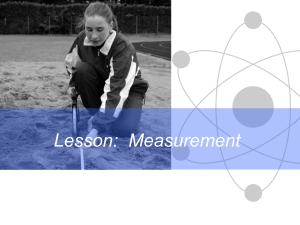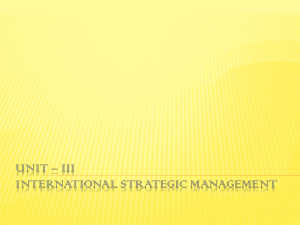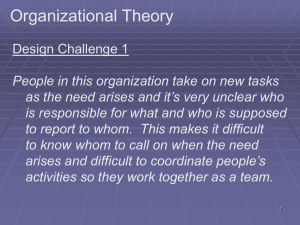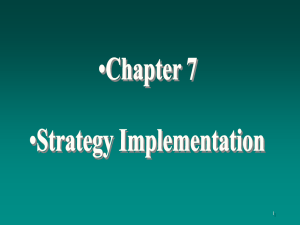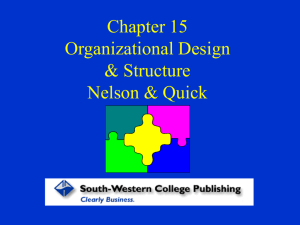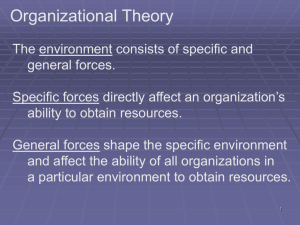MAN 4282 – Exam 1 Learning Objectives
advertisement
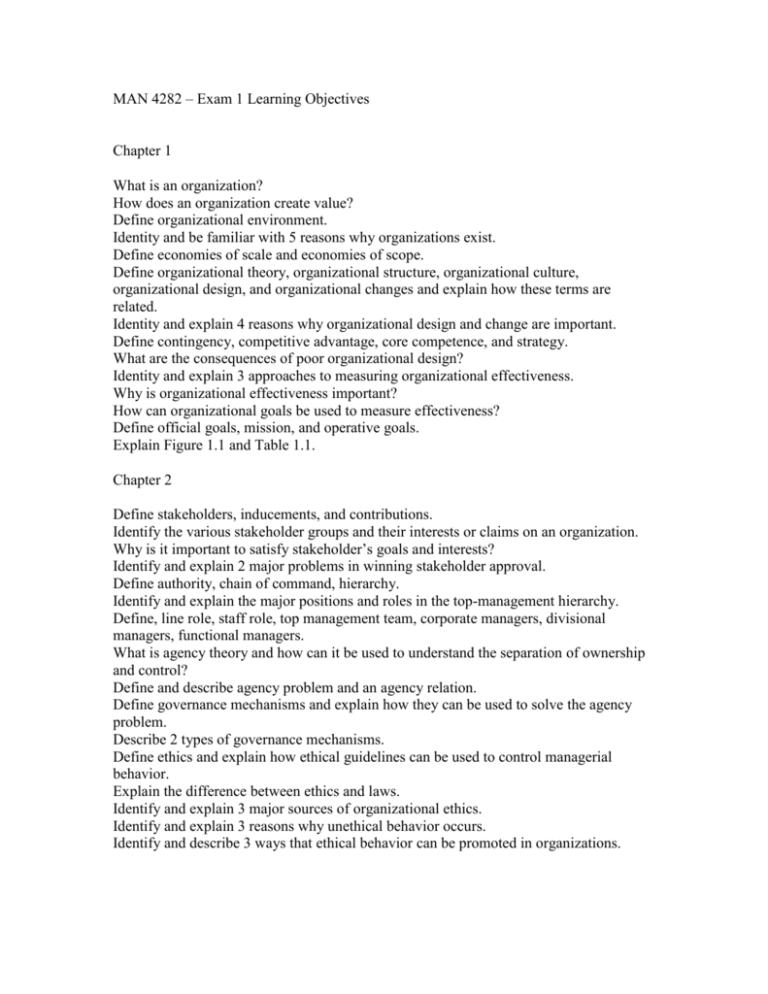
MAN 4282 – Exam 1 Learning Objectives Chapter 1 What is an organization? How does an organization create value? Define organizational environment. Identity and be familiar with 5 reasons why organizations exist. Define economies of scale and economies of scope. Define organizational theory, organizational structure, organizational culture, organizational design, and organizational changes and explain how these terms are related. Identity and explain 4 reasons why organizational design and change are important. Define contingency, competitive advantage, core competence, and strategy. What are the consequences of poor organizational design? Identity and explain 3 approaches to measuring organizational effectiveness. Why is organizational effectiveness important? How can organizational goals be used to measure effectiveness? Define official goals, mission, and operative goals. Explain Figure 1.1 and Table 1.1. Chapter 2 Define stakeholders, inducements, and contributions. Identify the various stakeholder groups and their interests or claims on an organization. Why is it important to satisfy stakeholder’s goals and interests? Identify and explain 2 major problems in winning stakeholder approval. Define authority, chain of command, hierarchy. Identify and explain the major positions and roles in the top-management hierarchy. Define, line role, staff role, top management team, corporate managers, divisional managers, functional managers. What is agency theory and how can it be used to understand the separation of ownership and control? Define and describe agency problem and an agency relation. Define governance mechanisms and explain how they can be used to solve the agency problem. Describe 2 types of governance mechanisms. Define ethics and explain how ethical guidelines can be used to control managerial behavior. Explain the difference between ethics and laws. Identify and explain 3 major sources of organizational ethics. Identify and explain 3 reasons why unethical behavior occurs. Identify and describe 3 ways that ethical behavior can be promoted in organizations. Chapter 3 Define organizational environment and organizational domain and explain why they are important. Describe and differentiate between an organization’s specific and general environments. Identify and describe the major sources of uncertainty in the organizational environment. Define environmental complexity, environment dynamism, and environmental richness. Why is environment uncertainty important? What is resource dependence theory and how can it be used by organizations to better manage the environment? What are symbiotic and competitive interdependencies? Identify and briefly describe strategies that can be used to manage symbiotic interdependencies. Identify and briefly describe strategies that can be used to manage competitive interdependencies. What is transaction cost theory and how can it be used by organizations to better manage the environment? Define transaction costs and bureaucratic costs. Identify and describe the major sources of transaction costs. How can transaction cost theory be used to help an organization decide when to choose and change strategies? Explain Figures 3.1, 3.3, and 3.7. Chapter 4 What is differentiation and why is it important? Explain control and coordination issues associated with differentiation. Define differentiation, division of labor, and specialization and explain how they are related. Identify, define, and describe the basic building blocks of differentiation (roles, functions, divisions). Define authority and control and explain how they are organizational roles and organizational structure. What is organizational complexity and how can it be measured? Define hierarchy. Define and differentiate between vertical differentiation and horizontal differentiation. Why is it important to balance differentiation and integration? Define subunit orientation. How does subunit orientation related to differentiation and integration? Define integration and explain the role and purpose of integrating mechanisms. Why is it important to balance centralization and decentralization? Define centralization and decentralization. Why is it important to balance standardization and mutual adjustment? Define standardization and mutual adjustment. What are formalization and socialization and how do they relate to standardization and mutual adjustment? What are rules and norms? Define, describe, and explain the differences between mechanistic and organic structures. Describe the contingency approach to organizational design. Explain Figures 4.2, 4.6, 4.8, and 4.10.






